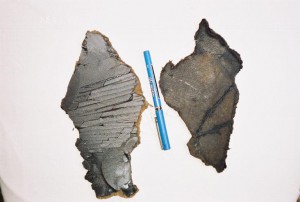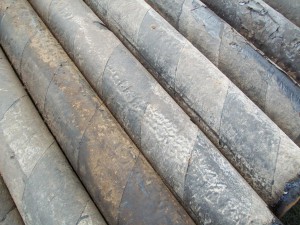October 2011, Vol. 238 No. 10
Features
Considering Asbestos And Old Pipelines

Asbestos coating on pipelines is not a popular topic with most pipeline companies. In fact they don’t even like to use the “A” word when describing the coating. Asbestos is a proven, effective, and durable means of protecting steel pipe from corrosion and the elements. For the most part, asbestos might be up to 50% percent of the felt wrapping around a length of line pipe with some tar type outer wrapping. Overall, this might mean there is as much as 25% asbestos in the complete coating.
Asbestos as a coating on pipelines was very popular until the Clean Air Act was enacted in 1965. It took a few years, but use of asbestos in new pipeline coatings disappeared before 1980. Today, asbestos continues to protect hundreds of thousands of feet of pipeline that were laid between 1920-1980.
Most of the misinformation over asbestos comes from regulations regarding exposure in an enclosed area such as wall and ceiling insulation in schools, offices and public buildings. When asbestos becomes dry and broken up, it is in a friable or free-flying and dry state and can be a contaminant if inhaled consistently by humans over time in concentrated amounts. The issue always comes down to whether the asbestos in question is friable. Coatings that contain friable asbestos are soft, dry, and pliable enough to crush normally in a human fist and thus release the asbestos fibers freely into the atmosphere.

Figure 1: Samples of coating with possible asbestos presence.
Asbestos in coatings is never in a friable state while on the pipeline. When a pipeline is cut and removed from the ground, the coating is only minimally disturbed. During excavation, the pipeline is almost always in open spaces such as outdoors on a pipeline right-of-way where it is impossible to have any concentrated exposure. Any workers would only have exposure for minutes out of days on jobs of short duration. Even so, responsible operators will use some sort of simple respirator over their nostrils as part of the prescribed standard safety equipment. In addition, the use of dampeners keeps the coating material from becoming friable. This can be done with a simple spray bottle of water with backup reserves in a larger tank nearby.
Regulators and bureaucrats can attempt to enforce laws related to enclosed environments in open areas, but most of these attempts have not been successful. Simple precautions when taken will prevent any problems with any Occupational Safety and Health Act (OSHA) enforcers. Using simple respirators while slicing or removing asbestos in preparation for cutting or welding pipe satisfies almost all OSHA requirements. Sometimes, an inexpensive air monitor placed nearby might stop any questions even though it seems frivolous, as it is impossible to measure any of these flying particles in an open-air operation.
As mentioned, a good practice during pipeline removal is to keep a tank or container of water nearby to keep freshly cut or sliced areas of coating damp while working with the pipe. At times it might be prudent or perhaps required to individually wrap each joint of pipe prior to loading. More often, if it is deemed necessary for transporting, operators will wrap all pipe ends at once after a truck is loaded. This method simply covers all the ends with one secured wrap.
As regards this type of coating on pipelines, the National Emission Standard for Asbestos, Subpart M, defines this type of asbestos or asbestos-containing material (ACM) as a Category II nonfriable ACM and means any material containing more than 1% asbestos as determined using the methods specified (Polarized Light Microscopy) that when dry, cannot be crumbled, pulverized, or reduced to powder by hand pressure. (Appendix E, Subpart E, 40 CFR part 763, section 1).

Figure 2: Removed 8-inch pipeline with coating intact.
In my experience of removing millions of feet of pipeline that for the most part were coated with ACM, I have never had occasion to witness this material in a dry state that was separated from the coating product. That is, the asbestos-containing material is embedded in a tar coating that is in turn wrapped in a fiberglass material, making the material almost impossible to separate. The tar is hard, particularly when it is cool or dampened, and at that point cannot be crumbled, pulverized or reduced to powder by hand pressure. I will contend that the method of making this type of ACM friable does not occur. Possibly, the notion came from asbestos removal in buildings where very loose asbestos is the norm, but in my experience it does not occur in pipeline coatings, pipeline removal or pipeline deconstruction.
Testing Labs
Prior to removing old coated pipelines, it is prudent to test the coating for asbestos, especially if the pipeline was laid between 1920-1980. Samples of the coating should be collected along the length of the pipeline to be removed and sent to testing labs to determine the exact content.

Figure 3: Example of a J-3 Resources lab analysis report.
In most metropolitan areas, there are labs where these simple tests can be performed. In Houston, J-3 Resources can do a number of tests for chemical analysis or embedded properties. As of this writing, J-3 charges $36 per sample to test for the presence and amounts of asbestos and the type of asbestos particle present in the sample. J-3 provides all pertinent documentation regarding the test results. J-3 is one of several testing companies in Houston, and they perform up to 50 of these tests per month. Results are generally ready within hours or overnight.
Pipe-cleaning Process
ACM coated pipes that require rehabilitation can be cleaned “over the ditch” without totally being taken out of service. Cleaning machines or “line-traveling machines” move along the pipeline while removing the pipe coating from the exterior. The coating residue either falls into the ditch (where it was laying before) or is caught in bags and disposed of in designated landfills or other approved sites. These sites charge upwards of $40 per ton and provide documentation.
Another way to clean-coated pipelines is to transport the removed pipeline so that no debris of any kind falls on public property to a central staging area. At the staging area, the pipe is sliced and cleaned using a track hoe modified with a special slice/cleaning attachment on the bucket. The removed coating is immediately picked up and deposited in a “roll off box” with secured tarps. When each box is filled with removed coating, it is transported along with a licensed and certified asbestos supervisor to the proper landfill for deposit. There is a paper trail for the entire process.
Pipeline recyclers such as Pipeline Equities will remove ACM-coated pipelines, load them onto trucks and transport them to a pipeline service yard that is certified in asbestos cleaning. Or, the company will clean the pipe in situ using line-cleaning machines. Pipeline Equities provides certified contractors/supervisors on any job where asbestos is or might be an issue.
Pipe Service Yards
Some pipe service yards are certified to remove asbestos coating from pipe. They have the proper machines to rapidly clean and remove the coating (whether or not the coatings contain asbestos) down to bare metal. Most of these yards are able to perform other rehabilitation functions such as beveling, straightening, cutting and welding together pieces on a custom basis. Most can also perform interior cleaning, end finishing and dent removal.
Among the list of pipe service yards are CPS in Houston and Lone Star, TX; Pioneer in El Reno, OK; and Stauffer Pipe Services in Houston. These companies can handle just about any type of exterior pipe cleaning of various coatings. All are licensed for ACM and can handle the product with proper abatement and disposal methods and documentation. Additionally, Stauffer can deploy field crews because it has portable equipment. CPS has facilities for long-term storage for large amounts of pipe.
Pipe-cleaning Expense
Cleaning expenses for removing ACM from pipelines can run from $1-3 per foot in a certified pipeline service yard with competent personnel who are versed in the proper methods to remove, sack, label and dispose of the ACM waste in the prescribed manner. The biggest factor is the transportation expense. Pipe is heavy, bulky, and expensive to load, unload and transport. The coating itself can contribute as much as 12% of the total weight of the pipe.
There are weights and bulk issues in handling pipe and the economics can quickly get out of hand. The other logistical problem is location. It is not always convenient or cost-effective to ship to Oklahoma, Houston, or east Texas to work on pipe that you excavate in Colorado and intend to ship to Michigan. Due to the high cost of transportation, it is important to handle some or all of the pipeline rehabilitation work while in the field.
Licensing
The area of licensing and certification is somewhat murky. Generally, people throw around the term “certified” pretty liberally. Basically, certification is education. A practitioner can receive certifications based on length of time in practice in the area, coursework via online or classroom instruction for a certain number of courses or classroom hours, or some combination of all of these methods. For asbestos certification, a supervisor goes to school for 40 classroom hours, takes a test upon completion of the coursework and, upon successful completion of the course and exam, receives a certificate or embossed piece of paper showing when and how the certification course was completed. This certificate satisfies state licensing requirements in Texas, Oklahoma, New Mexico and Louisiana.

Figure 4: David Roberts, vice president and instructor at Natec of Texas, Inc.
Natec of Texas, Inc., is a Houston-based provider of education and certification for asbestos handling. David Roberts, vice president, is an instructor for these courses that lead to licensing in various states.
Conclusion
This article is not meant to be: 1) technical in nature, or 2) an analysis of the regulations or authorities of the various federal and state agencies regarding asbestos. It is sufficient to state that asbestos in pipeline coatings is not friable and not a hazardous material by nature, even though some lawyers may attempt to make it seem so. It takes great effort to make these products friable and thus potentially a problem to human health. Even so, for the pipeline industry, even if friable conditions exist, work is done in the open air and not in enclosed conditions. The products are not considered a hazard to human health when in the open air.
Pipeline Equities and other pipeline removal companies have removed more than 50 million feet of out of service pipelines in the U.S. The author knows of no instance of an employee or field worker having problems with anything related to asbestosis as a result of working on the removal process.
Author
David Howell has been in the pipeline salvage and recovery business for 26 years. His company, Pipeline Equities, also brokers and appraises pipelines. He is a designated Senior Right-of-Way Agent through the International Right-of-Way Association with Environmental and Acquisition/Negotiation Certifications and a graduate of Texas A & M-Kingsville. He is the author of Pipeline Recovery Manual and Pipeline Appraisal Handbook. He can be reached at davidhowell@pipelineequities.com. References for this article are available on request from the author at the above e-mail address.






Comments